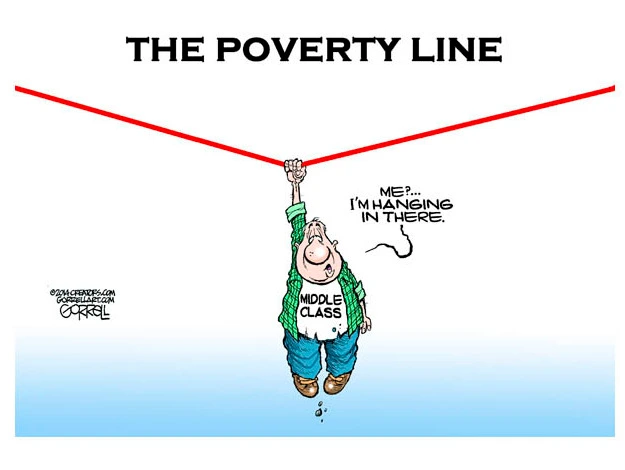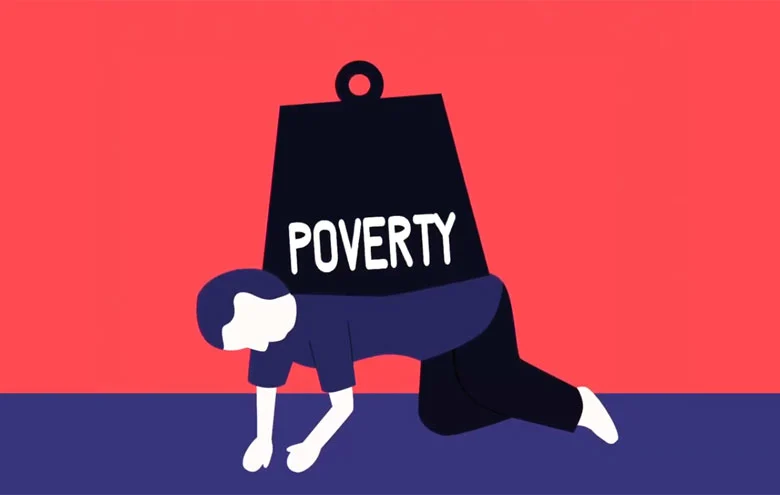Achieving a world without poverty is a complex and multi-faceted goal that requires a comprehensive approach involving various strategies and concerted efforts from governments, organizations, communities, and individuals.
Here we’ll try some strategies that will answer your question “How can we achieve no poverty” The world we live in is plagued by a persistent problem: poverty.
Despite significant progress in recent decades, millions still struggle to meet their basic needs, suffering from hunger, malnutrition, lack of education and healthcare, and limited opportunities.
Step-by-Step Process to understand How Can We Achieve No Poverty
These steps help you understand the complete cycle to reducing poverty. You will also learn How Does Education Reduce Poverty.
Defining Poverty: Absolute vs. Relative
Poverty is a complex concept with various interpretations and measurements depending on the context. Two primary approaches to defining poverty are:
1. Absolute Poverty:
- Defined by a set income threshold below which individuals cannot afford basic necessities for survival, such as food, shelter, clothing, and healthcare.
- This threshold is often based on a minimum calorie intake required for a healthy life and varies according to factors like location, climate, and cost of living.
- The World Bank currently defines extreme poverty as living on less than $1.90 per day (PPP), based on international benchmarks.
- Absolute poverty focuses on the inability to meet basic needs, regardless of the broader societal context.
2. Relative Poverty:
- Defined as living below a certain percentage of the median income within a specific society or region.
- This approach considers the distribution of income within a society and focuses on individuals who fall behind the average standard of living.
- Poverty lines are adjusted regularly to reflect changes in inflation and income levels.
- Relative poverty emphasizes economic disparity and social exclusion within a community.
| Feature | Absolute Poverty | Relative Poverty |
|---|---|---|
| Focus | Inability to meet basic needs | Falling behind the average standard of living |
| Measurement | Fixed income threshold | Percentage of median income |
| Context | Universal standard | Reflects societal context |
| Concern | Survival and basic needs | Social exclusion and inequality |
Examples of Poverty
- Absolute poverty: A family living in a rural area with limited resources and struggling to afford daily meals falls under absolute poverty regardless of the income distribution in their community.
- Relative poverty: A single mother working two jobs in a high-income city might still be considered relatively poor if her earnings fall below the national median income for single-parent households.
Global poverty rate and its implications
As of 2022, the global extreme poverty rate stands at 9.2%, meaning that roughly 719 million people live on less than $2.15 per day. This represents a significant decrease from the 1990 rate of 36%, highlighting progress in poverty reduction over the past decades.
However, despite this progress, the implications of poverty remain severe:
1. Hunger and Malnutrition: Poverty is a major contributing factor to hunger and malnutrition, especially among children. This can lead to stunted growth, impaired cognitive development, and increased vulnerability to diseases.
2. Lack of Access to Education and Healthcare: Poverty limits access to quality education and healthcare, perpetuating poverty cycles and hindering individual and societal development.
3. Social Exclusion and Inequality: Poverty often leads to social exclusion and discrimination, further exacerbating vulnerabilities and limiting opportunities for advancement.

4. Conflict and Instability: Poverty and inequality can be drivers of conflict and instability, both within and between nations.
5. Environmental Degradation: Poverty can motivate unsustainable practices as individuals struggle to meet their basic needs, leading to environmental degradation and further jeopardizing future generations.
Addressing poverty requires a multifaceted approach:
- Promoting economic growth and development to create more jobs and opportunities.
- Investing in education and healthcare to empower individuals and improve their quality of life.
- Strengthening social safety nets to support vulnerable groups.
- Promoting gender equality and empowering women and girls.
- Addressing conflict and violence to create a peaceful environment conducive to development.
- Investing in sustainable development to ensure long-term progress and protect the environment.
Devastating Consequences of Poverty
The consequences of poverty are devastating and far-reaching, impacting individuals, families, and entire communities in various ways:
1. Hunger and Malnutrition:
Lack of income limits access to sufficient and nutritious food, leading to hunger, malnutrition, and stunted growth, particularly among children. This can have lifelong consequences for physical and cognitive development.
2. Limited Access to Education and Healthcare:
Poverty restricts access to quality education and healthcare, hindering individual potential and perpetuating poverty cycles.
Children from poor families are more likely to drop out of school and miss out on crucial learning opportunities. Inadequate healthcare can result in preventable illnesses and premature deaths.
3. Social Exclusion and Inequality:
Poverty often leads to social exclusion and discrimination, further marginalizing individuals and communities. This can limit access to opportunities, resources, and social support, creating a vicious cycle of poverty and disadvantage.

4. Increased Vulnerability to Exploitation:
Poverty makes individuals vulnerable to exploitation and abuse, particularly in the labor market and informal sectors. This can lead to unfair labor practices, human trafficking, and other forms of exploitation.
5. Environmental Degradation:
Poverty can fuel unsustainable practices as individuals resort to deforestation, overgrazing, and other harmful activities to meet their basic needs.
This contributes to environmental degradation, further jeopardizing livelihoods and exacerbating existing vulnerabilities.
6. Mental and Physical Health Issues:
The stress and hardship associated with poverty can lead to mental health problems like anxiety and depression. The poor living conditions and lack of access to healthcare can contribute to physical health issues and chronic diseases.
7. Increased Crime and Violence:
Poverty can create an environment where crime and violence are more likely to occur. This can further destabilize communities and hinder development efforts.
8. Limited Political Participation and Social Mobility:
Poverty can limit opportunities for political participation and social mobility, perpetuating existing power structures and inequalities.
9. Intergenerational Transmission of Poverty:
Children born into poverty are more likely to experience poverty themselves, creating a cycle of disadvantage that can be difficult to break.
These consequences highlight the urgency of addressing poverty and its multifaceted impacts. By implementing effective strategies that promote economic growth, invest in human capital, and address social inequalities.
We can work towards a world where poverty no longer hinders the lives and opportunities of individuals and communities.
The Concept of Zero Poverty and Its Importance
Zero poverty is a bold and inspiring vision that aims to eradicate extreme poverty and ensure that everyone can meet their basic needs and lead a dignified life.
This vision goes beyond simply providing individuals with enough income to survive; it encompasses access to education, healthcare, sanitation, clean water, and other essential services.
Achieving zero poverty is not just a moral imperative, it is also crucial for sustainable development and global peace and security.
Poverty creates a breeding ground for conflict, instability, and environmental degradation. It also hinders economic growth and limits the potential of millions of individuals.
The importance of zero poverty lies in its multifaceted benefits:

1. Improved Human Development:
Achieving zero poverty would significantly improve human development indicators like education, health, and well-being. It would empower individuals and communities, allowing them to reach their full potential and contribute to society.
2. Economic Growth and Prosperity:
By lifting individuals out of poverty, we unlock their economic potential and create new markets and opportunities. This leads to increased economic activity, innovation, and overall prosperity.
3. Reduced Inequality and Social Justice:
Eradicating poverty promotes a more just and stable society where everyone has a fair chance to succeed. This reduces social tensions and creates a more stable and peaceful world.
4. Environmental Sustainability:
When individuals have their basic needs met, they are less likely to resort to unsustainable practices like deforestation or overfishing. This contributes to a healthier planet and a more sustainable future for all.
5. Global Peace and Security:
Poverty can fuel conflict and instability. By addressing the root causes of poverty, we can create a safer and more peaceful world for everyone.
Achieving zero poverty requires a global commitment and collaboration from governments, businesses, civil society organizations, and individuals. It demands a multi-pronged approach that includes:
- Promoting inclusive economic growth and job creation.
- Investing in education and healthcare.
- Strengthening social safety nets.
- Empowering women and girls.
- Addressing climate change and environmental degradation.
- Promoting good governance and transparency.
The journey to zero poverty will not be easy, but it is a journey worth taking. By working together, we can build a future where everyone can thrive and achieve their dreams.

Causes of Poverty
Poverty is a complex issue with no single cause. It is a result of a multitude of interconnected factors that create a vicious cycle of disadvantage. Understanding these causes is crucial for developing effective strategies to address and eradicate poverty.
1. Economic Factors:
- Unemployment and underemployment: Limited access to decent jobs and opportunities for income generation are major drivers of poverty. Factors like automation, economic shocks, and lack of relevant skills can exacerbate this.
- Unequal distribution of wealth and income: The gap between the rich and the poor continues to widen, leaving a large segment of the population struggling. This inequality restricts access to resources and limits opportunities for upward mobility.
- Exploitation and unfair trade practices: Unfair wages, unsafe working conditions, and exploitation by corporations and governments contribute to poverty, particularly in vulnerable communities.
- Lack of access to resources: Limited access to land, water, credit, and markets hinders individuals’ ability to take part in the economy and generate income.
2. Social Factors:
- Lack of education and skills: Limited access to quality education and relevant skills training restricts individuals’ ability to find decent jobs and earn a living wage.
- Discrimination and exclusion: Discrimination based on race, gender, ethnicity, disability, and other factors can lead to social exclusion, limited access to resources, and fewer opportunities for advancement.
- Gender inequality: Unequal access to education, healthcare, and economic opportunities for women and girls perpetuates poverty among women and their families.
- Conflict and violence: War, civil unrest, and violence destroy infrastructure, displace communities, and disrupt economies, leading to poverty and instability.
- Environmental degradation and climate change: These factors disproportionately impact poor communities, leading to loss of livelihoods, food insecurity, and displacement.
3. Political Factors:
- Weak governance and corruption: Lack of transparency, corruption, and ineffective governance can hinder development efforts and exacerbate poverty.
- Inefficient policies: Policies that fail to address the needs of the poor or create disincentives for work can perpetuate poverty cycles.
- Lack of political will: A lack of commitment from governments and leaders to address poverty can hinder progress and leave millions behind.
4. Intergenerational Transmission:
- We can pass poverty down through generations, creating a cycle that is difficult to break. Children born into poverty are more likely to experience poverty themselves because of limited access to education, healthcare, and opportunities.
5. Global and Regional Factors:
- Global economic trends, trade policies, and international conflicts can all impact the economic well-being of individuals and communities, contributing to poverty.
- Debt burdens on developing countries can limit their ability to invest in poverty reduction programs and social services.
Strategies for Achieving Zero Poverty
Eradicating poverty is a monumental challenge, but it is a goal worth pursuing.
By understanding the complex causes of poverty and implementing effective strategies, we can build a world where everyone can thrive. Here are some key strategies for achieving zero poverty:
1. Promoting Economic Growth and Development:
- Create decent jobs: Invest in infrastructure, promote small businesses and entrepreneurship, and foster innovation to create sustainable and inclusive economic opportunities.
- Promote sustainable development: Integrate environmental considerations into economic policies to ensure long-term prosperity and protect vulnerable communities.
- Strengthen financial systems: Provide access to credit and financial services, particularly for small businesses and women entrepreneurs.
- Promote fair trade and proper globalization: Ensure that global trade benefits all countries and contributes to poverty reduction.
2. Investing in Human Capital:
- Provide quality education for all: Ensure access to primary, secondary, and tertiary education, including vocational training and skills development programs.
- Invest in healthcare and nutrition: Provide universal access to healthcare, including preventive care and essential medicines.
- Promote early childhood development: Invest in programs that support the physical, cognitive, and social-emotional development of young children.
- Empower women and girls: Address gender disparities in education, healthcare, and economic opportunities to unlock their full potential and contribute to poverty reduction.
3. Strengthening Social Safety Nets:
- Implement social assistance programs: Provide targeted support to vulnerable groups, including the unemployed, elderly, and disabled.
- Establish minimum wage and labor protection policies: Ensure fair wages and working conditions for all workers.
- Develop social insurance schemes: Provide universal access to pensions and unemployment benefits.
- Invest in disaster risk reduction: Build resilience and preparedness to protect communities from natural disasters and climate shocks.
4. Addressing Conflict and Violence:
- Promote peacebuilding and conflict resolution: Invest in diplomacy, mediation, and other strategies to prevent and resolve conflicts peacefully.
- Provide humanitarian assistance: Support conflict-affected communities to meet their basic needs and rebuild their lives.
- Address the root causes of conflict: Tackle poverty, inequality, and social injustice to create a more peaceful and stable world.
5. Leveraging Technology and Innovation:
- Develop and use digital technologies: Promote access to digital infrastructure and tools to improve education, healthcare, and financial inclusion.
- Invest in sustainable and climate-smart technologies: Address environmental challenges and create new opportunities for economic development.
- Support research and development: Foster innovation in areas like agriculture, renewable energy, and healthcare to address poverty challenges.
6. International Cooperation and Mobilizing Resources:
- Strengthen global partnerships: Collaborate between governments, international organizations, NGOs, and private sector actors to share resources and expertise.
- Increase development help: Provide financial and technical help to developing countries to support their poverty reduction efforts.
- Address global debt burdens: Find sustainable solutions to manage the debt burdens of developing countries and free up resources for investment in poverty reduction.
- Promote good governance and transparency: Hold governments accountable for their commitments to poverty reduction and ensure efficient and equitable use of resources.
Challenges and Opportunities
While the goal of zero poverty is ambitious and attainable, several challenges and opportunities lie ahead:
Challenges:
- Identifying and Addressing Specific Needs: Different communities and individuals have diverse needs that require tailored interventions. This necessitates comprehensive data collection, analysis, and flexible implementation strategies.
- Mobilizing Resources: Achieving zero poverty requires significant financial and human resources at national and international levels. Building partnerships, leveraging innovative financing mechanisms, and tackling corruption are crucial.
- Overcoming Political and Institutional Barriers: Weak governance, bureaucratic inefficiencies, and lack of political will can hinder progress. Building strong institutions, promoting transparency, and fostering citizen participation are essential.
- Addressing Global Inequalities: Trade policies, global economic trends, and debt burdens can disproportionately impact developing countries. International cooperation and equitable trade practices are crucial.
- Adapting to Environmental Challenges: Climate change, natural disasters, and environmental degradation can exacerbate poverty. Investing in sustainable development, climate-smart technologies, and disaster risk reduction is critical.
- Addressing Conflict and Violence: Conflict and violence destroy livelihoods, displace communities, and hinder development efforts. Promoting peacebuilding, conflict resolution, and addressing root causes are crucial.
- Technological Divide: Unequal access to technology and digital skills can further marginalize vulnerable communities. Bridging the digital divide and ensuring equitable access to technology are essential.
Opportunities:
- Technological advancements: Technologies like AI, big data, and digital financial services offer innovative solutions for poverty reduction, including precision targeting, personalized interventions, and improved access to services.
- Growing global awareness: Increased public awareness and global commitment to achieving zero poverty can drive political will, mobilize resources, and incentivize action.
- Emerging models of development: Social entrepreneurship, impact investing, and collaborative partnerships offer new approaches to poverty reduction that are more efficient, sustainable, and inclusive.
- Increased data availability: Improved data collection and analysis tools allow for better monitoring and evaluation of poverty reduction programs, leading to more effective interventions.
- Rise of civil society movements: Grassroots movements and community-driven initiatives play a crucial role in holding governments accountable, advocating for change, and empowering communities to overcome poverty.
- Empowerment of women and girls: Investing in the education, healthcare, and economic opportunities of women and girls can have a multiplier effect on poverty reduction and overall development.
- Increased focus on social safety nets: Expanding access to social protection programs, including universal basic income and conditional cash transfers, can provide critical support to vulnerable groups and reduce poverty levels.
Final Words
The eradication of poverty is not just a dream; it is a necessary and achievable goal. By understanding its complex causes, implementing effective strategies, and embracing innovation and collaboration, we can build a world where everyone can thrive.
This journey requires a commitment from individuals, communities, and leaders across all levels. We must work together to:
- Promote inclusive economic growth and create decent jobs.
- Invest in education, healthcare, and early childhood development.
- Empower women and girls and address gender disparities.
- Strengthen social safety nets and provide support to vulnerable groups.
- Promote peace and address the root causes of conflict and violence.
- Leverage technology and innovation for sustainable development.
- Mobilize resources and foster global cooperation.
Achieving zero poverty is not just a moral imperative; it is essential for a more just, equitable, and prosperous world.
By embracing this challenge and taking action today, we can pave the way for a brighter future where poverty is a relic of the past. We hope you enjoyed our article on can we achieve no poverty.

